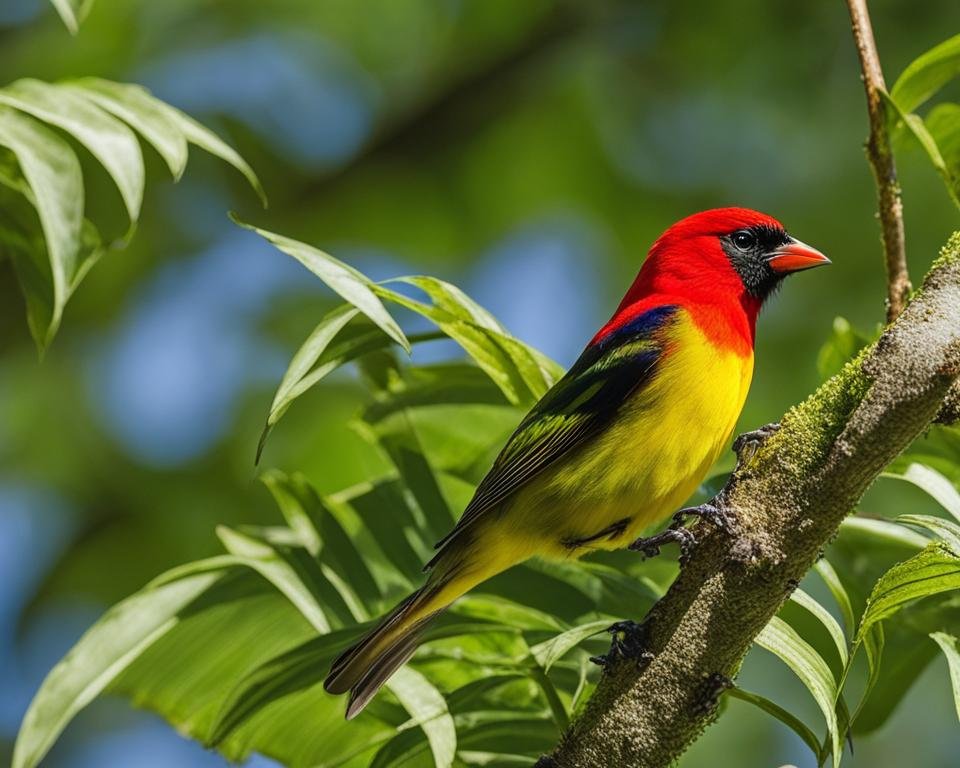If you’re a bird lover looking for a serene spot to witness the magic of nature, then Montgomery Bell State Park is the perfect destination for you. Renowned for its diverse bird species, breathtaking landscapes, and natural beauty, this state park is a birder’s paradise.
In this article, we will explore the avian diversity of Montgomery Bell State Park, highlight the best birding trails, provide tips and resources for bird watching, and discuss the conservation efforts that make this park a precious gem.
Exploring the Avian Diversity in Montgomery Bell State Park
Montgomery Bell State Park is a treasure trove for birding enthusiasts. With its diverse range of habitats, the park attracts various bird species throughout the year. From forested areas to water bodies, the park has it all for birdwatchers.
The park’s diverse habitats are home to a range of bird species, including warblers, woodpeckers, hawks, and eagles. The lush forests surrounding the park’s lakes are a particular hotspot for birding. Wood ducks, ospreys, and bald eagles are common sights here. The open fields surrounding the park’s boundaries are also great locations for spotting birds of prey, including red-tailed hawks and American kestrels.
When exploring the park, it’s important to follow proper birding techniques and etiquette. This includes staying on designated trails and avoiding disturbing the birds and their habitats. Remember to keep a safe distance from birds of prey, as they can be aggressive when defending their nests. Always remain cautious and respectful of the birds and their environment.
Don’t forget to bring your binoculars and a spotting scope, as they are essential tools for birding. With good technique and the right equipment, you can spot some of the rarest bird species in the park.
“With its diverse habitats, Montgomery Bell State Park is a prime location for birding. I’ve seen some of the rarest bird species here, and it’s always a delight to be surrounded by the park’s natural beauty.” – Sarah, a seasoned birder and frequent visitor to Montgomery Bell State Park.
Best Birding Trails in Montgomery Bell State Park
If you’re looking to experience the best birding trails that Montgomery Bell State Park has to offer, you won’t be disappointed! Here are just a few of the top trails to add to your itinerary:
Burnett Woods Trail
Located in the park’s southwestern corner, this 2.5-mile trail winds its way through a variety of habitats, including mixed hardwood forest and wetland areas. Keep an eye out for woodpeckers, warblers, and wrens along the way.
The Narrows of the Harpeth Trail
For a more challenging hike, head to the Narrows of the Harpeth Trail, which features steep inclines and rocky terrain. The payoff? A stunning view of the Harpeth River and the chance to spot bald eagles and osprey soaring overhead.
Lake Acorn Trail
If waterfowl are your thing, the Lake Acorn Trail is a must-do. This easy 1.5-mile loop follows the shore of Lake Acorn and offers prime views of ducks, geese, and herons out on the water.
Remember to pack plenty of water, snacks, and sunscreen before hitting the trails. It’s also a good idea to bring along a pair of binoculars and a field guide to help with bird identification. Happy birding!
Unique Bird Species in Montgomery Bell State Park
Montgomery Bell State Park is home to a diverse range of bird species, some of which are rare or endangered. Here are some of the unique bird species you might spot during your birding adventure in the park:
- Eastern Whip-poor-will: These birds are known for their distinctive calls that sound like “whip-poor-will.” They are mostly active at dawn and dusk.
- Yellow-throated Warbler: You can identify these birds from their striking black and white striped heads and bright yellow throats.
- Bald Eagle: One of the most majestic bird species found in the park, the bald eagle is an iconic symbol of American strength and freedom.
- Hooded Warbler: These birds are known for their striking black and yellow plumage, and their unique ability to breed in different habitats within the park.
- Brown-headed Nuthatch: You might hear these birds before you see them, as they are known for their distinctive “yank-yank” calls. Look for their small size and blue-gray plumage.
Observing these unique bird species in their natural habitats is an incredible experience that any birding enthusiast will cherish. Remember to use proper birding techniques and etiquette to protect the park’s diverse wildlife.

Birding Tips and Resources
For a successful birding experience at Montgomery Bell State Park, it is essential to come prepared with the right equipment and resources. Here are some tips to make the most out of your birding excursion:
Birding Equipment
Having the proper equipment can make your birding experience more enjoyable and productive. Consider bringing binoculars, a spotting scope, and a field guide to help identify different bird species. A camera can also be handy for capturing photos of your sightings.
Recommended Field Guides
Montgomery Bell State Park has a diverse range of bird species, and it can be challenging to find and identify them all. A field guide can be a useful tool for helping you identify and learn more about different bird species. Some recommended field guides for birding at Montgomery Bell State Park include The Sibley Guide to Birds and Peterson Field Guide to Birds of Eastern and Central North America.
Online Resources
The internet is a valuable resource for birdwatchers. There are several online resources available to help you learn more about the different bird species found at Montgomery Bell State Park. Some useful websites include Audubon, eBird, and All About Birds. These tools provide information on bird identification, behavior, and habitat requirements.

“Remember to respect the birds and their habitat when birding at Montgomery Bell State Park. Avoid disturbing nesting birds and sensitive habitats, and always practice good birding etiquette.”
Birding Etiquette
When birding in Montgomery Bell State Park, it is important to respect the birds and their habitat. Here are some tips for practicing good birding etiquette:
- Avoid disturbing nesting birds or birds engaged in courtship
- Stay on designated trails and avoid stepping on vegetation or disturbing the soil
- Do not use playback or recorded calls to attract birds
- Do not approach birds too closely; maintain a respectful distance
- Always follow posted park rules and regulations
By following these guidelines, you can help protect the natural habitat and ensure a positive birding experience for all visitors to Montgomery Bell State Park.
Birding Conservation Efforts and Citizen Science in Montgomery Bell State Park
Birding in Montgomery Bell State Park goes beyond the thrill of spotting various species. It also offers the opportunity to contribute to conservation efforts and citizen science initiatives.
The park collaborates with various nonprofit organizations and birding societies to collect data on bird populations and their habitats. By participating in citizen science programs, birders can actively contribute to the conservation of the park’s diverse bird species.
One such initiative is the annual Christmas Bird Count, organized by the National Audubon Society. This program enlists volunteers to count birds within a designated area and provide valuable data on bird populations to researchers and conservationists.
Birders can also participate in eBird, an online platform that allows birders to log their sightings and contribute to a global database of bird observations. This information is used by scientists and conservationists to track bird populations and inform conservation efforts.
Montgomery Bell State Park also offers educational programs and events that focus on birding and conservation. These programs educate visitors on the importance of preserving habitats and protecting the park’s diverse bird species for future generations.
By taking part in these conservation efforts and citizen science initiatives, birders can make a meaningful contribution to the preservation of Montgomery Bell State Park’s avian diversity.
FAQ
What makes Montgomery Bell State Park a popular destination for birding?
Montgomery Bell State Park is known for its diverse bird species and varied habitats, making it a prime location for birding enthusiasts. The park’s mix of woodlands, lakes, and open fields provide an ideal environment for a wide range of bird species.
What bird species can I expect to see in Montgomery Bell State Park?
Montgomery Bell State Park is home to a variety of bird species, including but not limited to American bald eagles, ospreys, great blue herons, and various species of warblers, finches, and woodpeckers. The park’s diverse habitats attract both migratory and resident bird species.
Which are the best birding trails in Montgomery Bell State Park?
Montgomery Bell State Park offers several birding trails that provide excellent bird-watching opportunities. Some of the top trails for birding include the Lake Acorn Trail, the Ore Pit Trail, and the Acorn Loop Trail. These trails traverse different habitats and offer chances to spot various bird species.
Are there any unique or rare bird species in Montgomery Bell State Park?
Yes, Montgomery Bell State Park is known for hosting unique bird species. It provides habitats for rare and endangered species such as the Cerulean Warbler and the Red-headed Woodpecker. Birders may have the chance to spot these elusive and impressive birds during their visit to the park.
What tips and resources are available for birding in Montgomery Bell State Park?
To enhance your birding experience in Montgomery Bell State Park, it is recommended to bring binoculars, a field guide on bird identification, and appropriate clothing for outdoor exploration. Additionally, there are various online resources and websites dedicated to bird identification and research that can help you further delve into the world of birding.
How can I get involved in bird-related conservation efforts at Montgomery Bell State Park?
Montgomery Bell State Park encourages visitors to engage in bird-related conservation efforts. One way to get involved is by joining citizen science initiatives that monitor bird populations and their habitats. By participating, you can contribute to a better understanding of the park’s avian diversity and help in its conservation.
